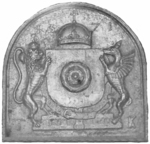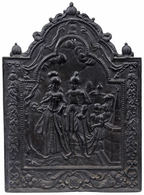-
222
Description: Arched rectangular central panel with ‘nutshell’ edging on a broad fillet; crowned figure, holding a sceptre in his right hand, sitting in a chariot drawn to the left by two horses with ostrich feather head-dresses; the whole upon a causeway with pilasters and masonry, and waves beneath; a heron flying to the left; above, swagged drapery with two tassels hanging from the centre; arched rectangular shaped border with fillet edging, symmetrical, flower bunches, descending from a ribbon loop; monogram centre bottom, between plant tendrils; on top, symmetrical scrolled plant tendrils.
Notes: The design is derived from a personification of Europe, one of a set of playing cards entitled 'Jeu de la Géographie', designed by Stefano della Bella (1677); a similarity with Queen Anne may not be coincidental; the flying heron has been copied from a print by Wenceslaus Hollar c.1658.
Copies of this fireback are known.
Inscription: SHR
- Decoration tags:
- 'Dutch' (shape)
- fillet (edging)
- whole carved pattern
- pictorial
- allegorical
- monogram
- text
- animals
- humans
- objects
Manufactured: in the late-17th to early-18th century in England.
Current location: Canons Ashby House, Canons Ashby, Northamptonshire, England.
Museum number: NT/L/CAN/M/79 (part of the National Trust museum group)
- Attached to series:
- SHR series
- British 'Dutch' style firebacks
-
269
Description: Arched; cavetto edging; crowned plain shield bearing a Tudor rose, with crowned lion and dragon supporters, with garter and motto; date split by crown.
Notes: The numerals are more typically 16th century in form than are found on copies produced from the late-19th century (see no. 178), suggesting this may be the original design; illustration from Dawson (1903).
Inscription: 15 71 / T K; [English royal, and garter, mottoes].
- Decoration tags:
- rounded arched (shape)
- cavetto (edging)
- whole carved pattern
- individual letters
- individual numbers
- heraldic
- royal
Manufactured: in 1571 in the Weald area of England.
Current location: not known.
Citation: Dawson, C., 1903, 'Sussex Iron Work and Pottery', Sussex Archaeological Collections, 46, pp. 1-54.
- Attached to series:
- Miscellaneous royal firebacks
-
178
Description: Arched; cavetto edging; crowned plain shield bearing a Tudor rose, with crowned lion and dragon supporters, with garter and motto; date split by crown.
Notes: A much-copied fireback; the numerals are uncharacteristically modern in form, suggesting they have been substituted on a later copy; a variant illustrated by Dawson (no. 269) shows a cross above the crown and more typically 16th century numerals. Formerly part of the Ade Collection (from Grove Hill, Hellingly, Sussex).
Copies of this fireback are known.
Inscription: 1571 HONI SOIT... ...DROI ? K
- Decoration tags:
- rounded arched (shape)
- fillet (edging)
- whole carved pattern
- individual numbers
- heraldic
- royal
- text
Manufactured: in the late-19th to early-20th century possibly in the Weald area of England.
Current location: Hastings Museum and Art Gallery, John's Place, Bohemia Road, Hastings, East Sussex, England.
Museum number: HASMG: 1952.51.45 (part of the Hastings Museum museum group)
- Attached to series:
- Miscellaneous royal firebacks
-
970
Description: Canted rectangle; twisted rope edging; date along the top; initials in triad across the middle, inside canted rectangular rope border; fleur-de-lys stamp repeated five times down each side.
Notes: The initials probably represent those of a married couple, the 'V' for their surname; it is relatively unusual for twisted rope edging to continue along the bottom of the plate. The back was found in Massachusetts and may have been brought there by an early colonist.
Inscription: 1626 / MVS
- Decoration tags:
- rectangular with canted top corners (shape)
- rope (edging)
- simple stamps
- carved stamps
- individual letters
- individual numbers
- heraldic
- text
Manufactured: in 1626 in the Forest of Dean area of England.
Current location: in private hands, Herndon, Virginia, United States of America.
- Attached to series:
- 1620s Dean series
-
984
Description: Arched rectangular central panel with additional arch above; bead and fillet edging; pictorial scene of, on the left, a tree next to a female and, in the centre, a male figure, both in eastern dress, a page behind holding a train, and to the right a short obelisk surmounted by a crescent, behind which is the head of a figure with a camel; behind is a small building also surmounted by a crescent, with clouds above; the word, ASIA, is centre bottom; identical shaped border with cavetto-moulded edging; a pomegranate on top with descending swags of drapery; at the sides, overlapping bunches of foliage suspended from ribbon bows; at the bottom, a central cartouche between fruit bunches; on top, a pomegranate with a descending serpent on each side, and a pomegranate on each shoulder of the plate.
Notes: A pastiche of the EUROPA design based on an engraving c.1642 of Friedrich Wilhelm, Elector of Brandenburg, and his wife, Luise Henriette of Oranje-Nassau, by Mathias Czwiczek, with the figures adopting very similar poses in an oriental setting; one of series depicting allegories of the four continents, in this instance Asia. A recasting.
Copies of this fireback are known.
Inscription: ASIA / MB
- Decoration tags:
- 'Dutch' (shape)
- fillet (edging)
- whole carved pattern
- pictorial
- allegorical
- monogram
- text
- animals
- humans
Manufactured: in the mid- to late-17th century possibly in the Siegerland area of Germany.
Current location: not known.
- Attached to series:
- 'Dutch' Arched arch types
- 'Dutch' Continents firebacks




